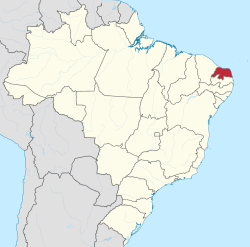Rio Grande do Norte | |
|---|---|
|
| |
 Location of State of Rio Grande do Norte in Brazil | |
| Coordinates: 5°44′S 36°33′W / 5.74°S 36.55°W | |
| Country | |
| Founded | March 7, 1948 |
| Capital and largest city | Natal |
| Government | |
| • Governor | Fátima Bezerra (PT) |
| • Vice Governor | Walter Alves (MDB) |
| • Senators | Rogério Marinho (PL) Styvenson Valentim (PODE) Zenaide Maia (PSD) |
| Area | |
| • Total | 52,796.791 km2 (20,384.955 sq mi) |
| • Rank | 22nd |
| Population (2022)[1] | |
| • Total | 3,302,729 |
| • Rank | 16th |
| • Density | 63/km2 (160/sq mi) |
| • Rank | 10th |
| Demonym | Potiguar or Norte-rio-grandense |
| GDP | |
| • Total | R$ 80.181 billion (US$ 14.874 billion) |
| HDI | |
| • Year | 2021 |
| • Category | 0.728[3] – high (14th) |
| Time zone | UTC-3 (BRT) |
| Postal Code | 59000-000 to 59990-000 |
| ISO 3166 code | BR-RN |
| License Plate Letter Sequence | MXH to MZM, NNJ to NOH, OJR to OKC, OVZ to OWG, QGA to QGZ, RGE to RGM, RGN |
| Website | rn.gov.br |
Rio Grande do Norte (UK: /ˌriːuː ˌɡrændi duː ˈnɔːrti/,[4] US: /- ˌɡrɑːn-/,[5] Portuguese: [ˈʁi.u ˈɡɾɐ̃dʒ(i) du ˈnɔʁtʃi] ) is one of the states of Brazil. It is located in the northeastern region of the country, forming the northeasternmost tip of the South American continent. The name literally translates as "Great Northern River", referring to the mouth of the Potenji River.
The capital and largest city is Natal. The state has 410 km (254 mi) of sandy beaches and contains Rocas Atoll, the only atoll in the Atlantic Ocean. The main economic activity is tourism, followed by the extraction of petroleum (the second largest producer in the country), agriculture, fruit growing and extraction of minerals, including considerable production of seasalt, among other economic activities.[6] The state is home to 1.7% of the Brazilian population and produces 1% of the country's GDP. In 2000-17 the murder rate rose by 655%, making Rio Grande do Norte the state with the highest murder rate in Brazil: 63.9 per 100,000.[7]
Tourist attractions in the state include the Cashew of Pirangi (the world's largest cashew tree),[8] the dunes and the dromedaries of Genipabu,[9] the beaches of Ponta Negra, Maracajaú and Pipa,[10] the Carnatal, Natal's carnival,[11] the sixteenth-century Forte dos Reis Magos fortification,[12] the hills and mountains of Martins,[13] the Natal Dunes State Park,[14] and others. The folklorist Luís da Câmara Cascudo was born and worked in the state. The state is the closest part of mainland Brazil to the archipelago of Fernando de Noronha.[15]
- ^ "2022 Census Overview" (in Portuguese).
- ^ "PIB por Unidade da Federação, 2021". ibge.gov.br.
- ^ "Atlas do Desenvolvimento Humano no Brasil. Pnud Brasil, Ipea e FJP, 2022". www.atlasbrasil.org.br. Retrieved 11 June 2023.
- ^ "Rio Grande do Norte". Lexico UK English Dictionary. Oxford University Press. Archived from the original on 28 August 2022.
- ^ "Rio Grande do Norte". Merriam-Webster.com Dictionary. Merriam-Webster. Retrieved 16 May 2019.
- ^ "Notícia inválida". Tribuna do Norte. Archived from the original on 6 October 2011. Retrieved 13 November 2011.
- ^ Darlington, Shasta (10 August 2018). "A Year of Violence Sees Brazil's Murder Rate Hit Record High". The New York Times. Retrieved 22 January 2020.
- ^ "UOL – Página não encontrada". Viagem.uol.com.br. Archived from the original on 26 July 2011. Retrieved 13 November 2011.
- ^ "Genipabu". Nataltrip.com. Archived from the original on 14 July 2011. Retrieved 13 November 2011.
- ^ [1] Archived 4 May 2008 at the Wayback Machine
- ^ "GloboEsporte.com > Seleção Brasileira – NOTÍCIAS – Carnatal, arma potiguar para sediar a Copa". Globoesporte.globo.com. 24 August 2007. Retrieved 13 November 2011.
- ^ "Fortaleza dos Reis Magos". Nataltrip.com. Archived from the original on 14 July 2011. Retrieved 13 November 2011.
- ^ "Martins". Nataltrip.com. Archived from the original on 14 July 2011. Retrieved 13 November 2011.
- ^ [2] Archived 15 July 2009 at the Wayback Machine
- ^ "Fernando de Noronha". Turismodonordeste.com. Retrieved 13 November 2011.

